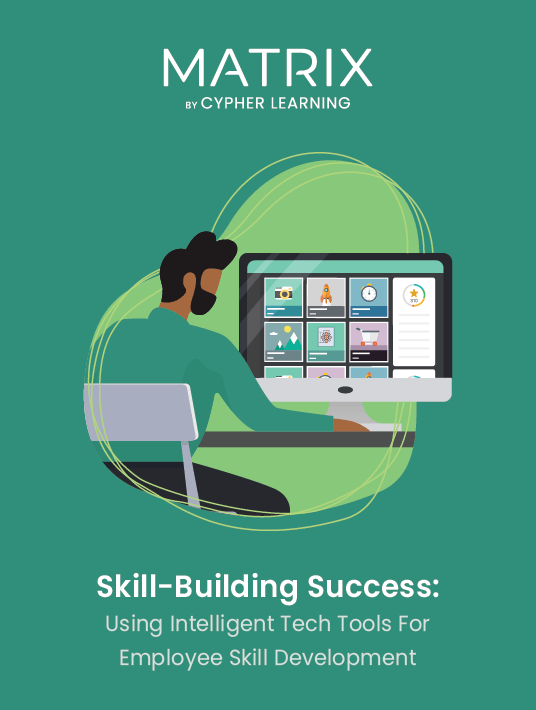Which Skills Should Your Employees Develop Through Competency-Based Training?
While there are other criteria that employees are looking for when hunting for a new job, such as the ability to work remotely, self-paced training, or flexible schedules, by including competency-based learning in your programs, they’ll be more likely to stick with your company, and you can easily track how well they are mastering workplace competencies.

What Is Competency-Based Learning?
Competency-based learning is a useful concept that helps employees master a specific skill before moving on to a more complicated one. For example, to become the head of recruitment in a company, one has to master talent and acquisition, diversity and inclusion, learning and development, and a few more other courses.
Employees can only move on to more advanced training once they master the basics. In other words, each competency represents a skill employees need to acquire to advance. Your learning management system (LMS) is a good starting point to implement and measure competency-based learning in your company.
Based on the previous example, once an employee masters all the goals you have set for them, they can easily demonstrate their knowledge and skills in a practical context, allowing them to advance their career.
Tips To Determine Which Skills Employees Need To Master
As an employer, you should be aware of all the skills your hires have so that you can help them upskill or expand their knowledge base. Luckily, technology makes it easier to assess these skills, create training programs for those particular capabilities and deliver them efficiently. Here are a few tips on how to do that:
1. Try Competency Modeling
To help your employees achieve workplace success, you should know the skills and knowledge they need to possess. These competencies can be split into hard and soft skills and play a key role in recruitment and hiring.
Once you create competency assessments, you already have a solid base of the training programs and learning materials you need to prepare.
It’s also important to gather data about each job profile to associate specific competencies with that job role or duty. Another reason for the growing popularity of modeling is the ability to reveal strengths and weaknesses. For example, sales representatives need product knowledge, good communication, and time-management skills. However, they also need to know how to deal with unpredictable situations and own information-gathering skills.
While people often associate job descriptions with competency models, it’s good to know that the latter refers to the specific behaviors that employees must do to become successful.
Although each job has specific competencies, most fit under the core, functional, and leadership competencies. The core competencies [1] include general skills such as communication or teamwork, and most jobs require them to some degree. For an accountant, the functional competencies are job-specific, such as understanding how a financial program works. Last but not least, leadership competencies include decision-making abilities and can be applied to most jobs and positions.
While these competency models represent a benchmark for performance within the organization, it’s also useful to develop training programs focused on outcomes.
2. Do A Needs Assessment
A training needs assessment [2] helps you identify your employees' current levels of competency and skills and compares them to the desired level of competency in your company. This is an effective way to determine training needs. Instead of just assuming that all of your employees require training or the same level of training, you can conduct a needs assessment, then training needs analysis [3] to make informed decisions about how to bridge those gaps.
These assessments can be conducted anytime, but it’s better to perform them periodically, not only after hiring. An organization-wide survey can determine whether your employees lack digital skills to perform better at their job.
You can use the same approach to identify soft and hard skills. With a training platform survey, you can quickly gather information from employees based on their current job titles and create different training needs assessments surveys for employees: management, team members, etc.
3. Define Your Competencies
After the needs assessment, you need to define your competencies. It’s important to make them granular and avoid vague statements such as “should be able to work as part of a team.” Instead, ask questions that help you determine the most important skills and needs in your organization. For example, “What does it mean to work as part of a team?”, “What does a team player do in this organization?”
Once you have a clear idea of the most important competencies in your organization, it’s time to take each category and associate it with a set of competencies. Such as: “communicate ideas effectively” and “demonstrate problem-solving skills” for the teamwork category.
4. Associate Training With Competencies
Now for the fun part, competency-based training can begin. If you make sure to associate key competencies with training, you can rest assured that your program is effective and your employees go through the materials they need to learn while boosting learning outcomes [4].
For example, a course on “teamwork” or “effective communication” can teach the entire list of competencies associated with that category. Your training platform makes it easy to associate learning materials and assessments with specific competencies. A quiz that employees need to complete at the end of the module called “Communicate ideas effectively to your team members” can be associated with the “communicates ideas effectively” competency.
In the same LMS, you can create an open environment for communication by asking your employees to participate in a forum or group discussion on the same topic. They can share ideas on how to communicate effectively and get insights from one another, which helps them improve their skillset.
Key Takeaways
When it comes to skill-building success in your company, technology gives a helping hand. Although you need to pay close attention to every step, such as competency modeling, needs assessment, and competency defining, it pays off well in the end. You ensure your employees master the skills required for your job, and your company thrives.
Conclusion
Download the eBook Skill-Building Success: Using Intelligent Tech Tools For Employee Skill Development to learn how you can use modern technology to fuel employee growth. You can also join the webinar to discover how to create effective skill development programs for employees.
References
[1] SHRM
[2] The need for a Training Needs Analysis
[3] 10 Tips for conducting a training needs analysis when faced with managerial demand
[4] Boosting learning outcomes through competency-based training








